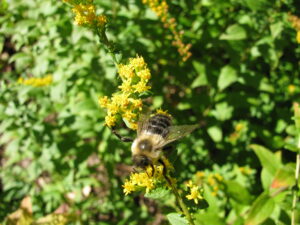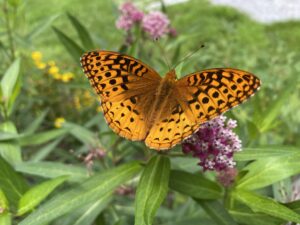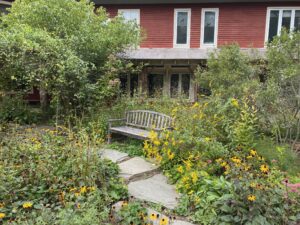(by Melissa Moore, NH Audubon Volunteer)
Sedum and Asters are fading in your flower garden. Buttercup and Acorn squash sit in storage. Garden cleanup now tops your to-do list. There are many strategies home gardeners can adopt to encourage the winter survival of pollinators. A starting point to remember is that New Hampshire is home to many insect species that are non-migratory and successfully overwinter in our cold climate. To survive the plunging winter temperatures these insects need certain types of habitats.

Let’s consider our native bee species that are ground nesting bees. Leaving a small patch of bare ground is a good practice to encourage ground nesting bees like the miner bee and the long-horned bee. The female miner bee builds a tunnel in the ground, lays one egg, and leaves a small supply of pollen and nectar as its food source. In this specialized underground tunnel, the miner bee eggs hatch and matures until it’s ready to emerge in the spring. Mason bees and Leaf cutter bees survive winter best when hollow plant stems are left in the garden. So don’t cut down those dried stems. Leave them standing at 8-24” tall. All species of New Hampshire’s native bee populations are important pollinators.

There are butterfly species that overwinter here as well. Some overwinter as eggs, some as caterpillars, and others in their adult form. Our familiar Tiger Swallowtail weather the cold in a chrysalis. Most butterflies that overwinter as a chrysalis find a sheltered place among your garden plants or shrubbery. Changes in their physiology allow them to endure the cold temperatures. As spring approaches they will resume development and emerge as adult butterflies. The Great Spangled Fritillary is an example of a butterfly that will overwinter as a caterpillar. They too, seek protected areas in the garden such as in the soil, rock crevices and seed pods – often near the host plant for that species. These overwintering strategies remind us that leaving our garden intact in the fall will benefit all the species that are using these areas for protection.

We recognize non-native honeybees and Monarch butterflies as key pollinators. However, a large population of native bees and butterfly species carry out this important work. It is helpful to adopt these pollinator friendly practices, so the native bees and butterflies are here in the spring when floral sources are emerging and the new growing season is set to launch.
